Process Optimization of Polishing Titanium Alloy Material with a Pulsating Air Jet
Abstract
1. Introduction
2. PAJP Experimental Platform
3. Design of Orthogonal Experiment
4. Experimental Results and Discussion
4.1. Range Analysis
4.2. Variance Analysis
5. Surface Roughness Prediction
5.1. Regression Model
5.2. Error Analysis
6. Conclusions
Author Contributions
Funding
Institutional Review Board Statement
Informed Consent Statement
Data Availability Statement
Conflicts of Interest
References
- Banerjee, D.; William, J.C. Perspectives on titanium science and technology. Acta Mater. 2013, 61, 844–879. [Google Scholar] [CrossRef]
- Yao, S.L.; Wang, G.Y.; Yu, H.; Wang, J.; Li, K.S.; Liu, S.; Zhang, X.C.; Tu, S.T. Influence of submerged micro-abrasive waterjet peening on surface integrity and fatigue performance of TA19 titanium alloy. Int. J. Fatigue 2022, 164, 107076. [Google Scholar] [CrossRef]
- Wang, Z.; Ma, Z.; Chen, T.; Fan, C.; Yu, T.; Zhao, J. Experimental investigation into the effect of process parameters on the Inconel 718 surface integrity for abrasive waterjet peening. Surf. Coat. Technol. 2023, 454, 129186. [Google Scholar] [CrossRef]
- Xia, G.; Wang, Z.; Yao, Q.; Sun, P.; Guan, H.; Wang, Y.; Fan, C.; Bian, D.; Zhao, D.; Zhao, Y. Modeling of material removal rate considering the chemical mechanical effects of lubricant, oxidant, and abrasive particles for aluminum chemical mechanical polishing at low pressure. Wear 2023, 530–531, 20502. [Google Scholar] [CrossRef]
- Fan, C.; Liu, K.X.; Chen, Y.G.; Zhao, J.; Khudoley, A. A new modelling method of material removal profile for electrorheological polishing with a mini annular integrated electrode. J. Mater. Process Technol. 2022, 305, 117589. [Google Scholar] [CrossRef]
- Zhao, J.; Xiang, Y.C.; Fan, C. A new method for polishing the inner wall of a circular tube with a soft abrasive rotating jet. Powder Technol. 2022, 398, 117068. [Google Scholar] [CrossRef]
- Axinte, D.A.; Kwong, J.; Kong, M.C. Workpiece surface integrity of ti-6–4 heat-resistant alloy when employing different polishing methods. J. Mater. Process Technol. 2009, 209, 1843–1852. [Google Scholar] [CrossRef]
- Guilherme, A.S.; Henriques, G.; Zavanelli, R.A.; Mesquita, M.F. Surface roughness and fatigue performance of commercially pure titanium and Ti-6Al-4V alloy after different polishing protocols. J. Prosthet. Dent. 2005, 93, 378–385. [Google Scholar] [CrossRef]
- Deng, Z.H.; Liu, Z.Q.; Zhang, X.H. Research of the science and technology development in high-speed and efficient processing field. J. Mech. Eng. 2010, 46, 106–120. [Google Scholar] [CrossRef]
- Liu, R.J.; Huang, Y.; Huang, Z.; Xiao, G.J. Experimental research on removal rate, surface quality and life expectancy of belt based on the belt grinding titanium alloy. Modul. Mach. Tool Autom. Manuf. Tech. 2010, 1, 18–21. [Google Scholar]
- Liang, Y.; Lin, J.J.; Wang, Y.H.; Chen, X.T.; Hou, J.T. Effect of abrasive belt polishing on surface integrity of specimens. Failure Anal. Prev. 2012, 7, 176–179. [Google Scholar]
- Dittrich, M.; Dix, M.; Kuhl, M.; Palumbo, B.; Tagliaferri, F. Process analysis of water abrasive fine jet structuring of ceramic surfaces via design of experiment. Procedia CIRP 2014, 14, 442–447. [Google Scholar] [CrossRef]
- Zhao, Q.; Zhang, L.; Fan, C. Six-direction pseudo-random consecutive unicursal polishing path for suppressing mid-spatial frequency error and realizing consecutive uniform coverage. Appl. Optics 2019, 58, 8529–8541. [Google Scholar] [CrossRef] [PubMed]
- Abdel-Rahman, A.A. A closed-form expression for an abrasive waterjet cutting model for ceramic materials. Math. Mod. Meth. Appl. Sci. 2011, 5, 722–729. [Google Scholar]
- Wang, J. A new model for predicting the depth of cut in abrasive waterjet contouring of alumina ceramics. J. Mater. Process Technol. 2009, 209, 2314–2320. [Google Scholar] [CrossRef]
- Naresh Babu, M.; Muthukrishnan, N. Investigation on surface roughness in abrasive water-jet machining by the response surface method. Mater. Manuf. Process 2014, 29, 1422–1428. [Google Scholar] [CrossRef]
- Fang, H.; Guo, P.J.; Yu, J.C. Surface roughness and material removal in fluid jet polishing. Appl. Opt. 2006, 45, 4012–4019. [Google Scholar] [CrossRef]
- Mohamad, A.; Zain, A.M.; Bazin, N.E.N.; Udin, A. A process prediction model based on cuckoo algorithm for abrasive waterjet machining. J. Intell. Manuf. 2015, 26, 1247–1252. [Google Scholar] [CrossRef][Green Version]
- Natarajan, Y. Experimental investigation on abrasive water jet polishing of stainless steel: A preliminary study. Int. J. Surf. Sci. Eng. 2021, 15, 67. [Google Scholar] [CrossRef]
- Liu, D.; Huang, C.Z.; Wang, J. Modeling and optimization of operating parameters for abrasive waterjet turning alumina ceramics using response surface methodology combined with Box-Behnken design. Ceram. Int. 2014, 40, 7899–7908. [Google Scholar] [CrossRef]
- Li, Z.Z.; Li, S.Y.; Dai, Y.F.; Peng, X.Q. Optimization and application of influence function in abrasive jet polishing. Appl. Opt. 2010, 49, 2947–2953. [Google Scholar] [CrossRef] [PubMed]
- Li, H.; Wang, J.; Kwok, N.; Nguyen, T.; Yeoh, G.H. A study of the micro-hole geometry evolution on glass by abrasive air-jet micromachining. J. Manuf. Process 2018, 31, 156–161. [Google Scholar] [CrossRef]
- Lari, M.R.S.; Papini, M. Inverse methods to gradient etch three-dimensional features with prescribed topographies using abrasive jet micro-machining: Part I–Modeling. Precis. Eng. 2016, 45, 272–284. [Google Scholar] [CrossRef]
- Lari, M.R.S.; Teti, M.; Papini, M. Inverse methods to gradient etch three-dimensional features with prescribed topographies using abrasive jet micro-machining: Part II—Verification with micro-machining experiments. Precis. Eng. 2016, 45, 262–271. [Google Scholar] [CrossRef]
- Zhang, L.; Ding, C.; Han, Y.J.; Zhang, Z.R.; Fan, C. Investigation into a novel pulsating cavitation air jet polishing method for Ti-6Al-4V alloy. Tribol. Int. 2022, 175, 107837. [Google Scholar] [CrossRef]
- Zhang, L.; Ding, C.; Wang, Z.; Fan, C. Multiphase flow field analysis and experimental study of pulsating air jet polishing. J. Manuf. Sci. Eng. 2022, 144, 121014. [Google Scholar] [CrossRef]
- Zhang, L.; Chen, W.; Ding, C.; Fan, C. Removal mechanism of submerged air jet polishing considering the state of abrasive particles. Int. J. Adv. Manuf. Technol. 2022, 12, 4099–4114. [Google Scholar] [CrossRef]
- Yadolah, D. Regression Analysis. In The Concise Encyclopedia of Statistics; Springer: New York, NY, USA, 2008. [Google Scholar] [CrossRef]
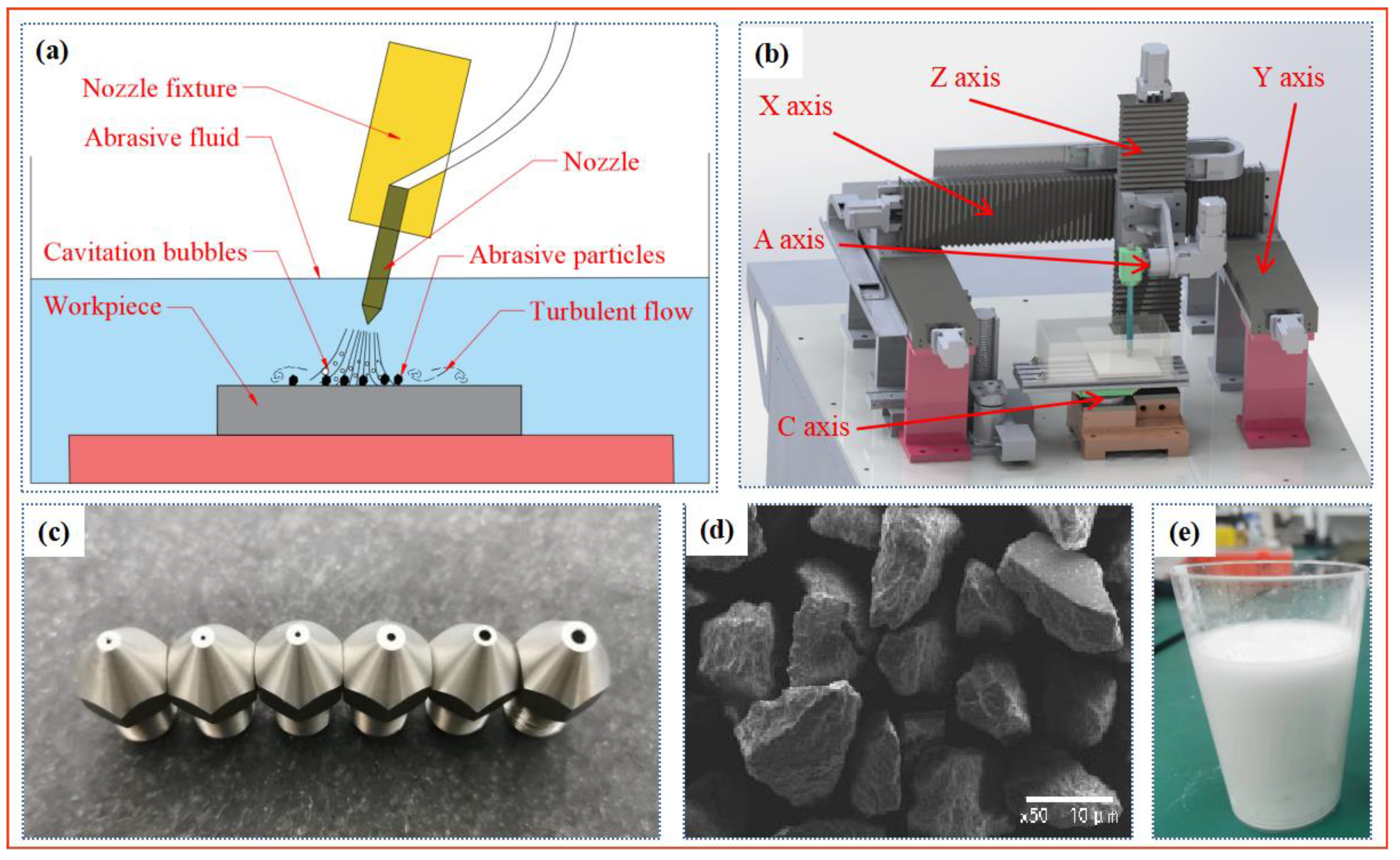
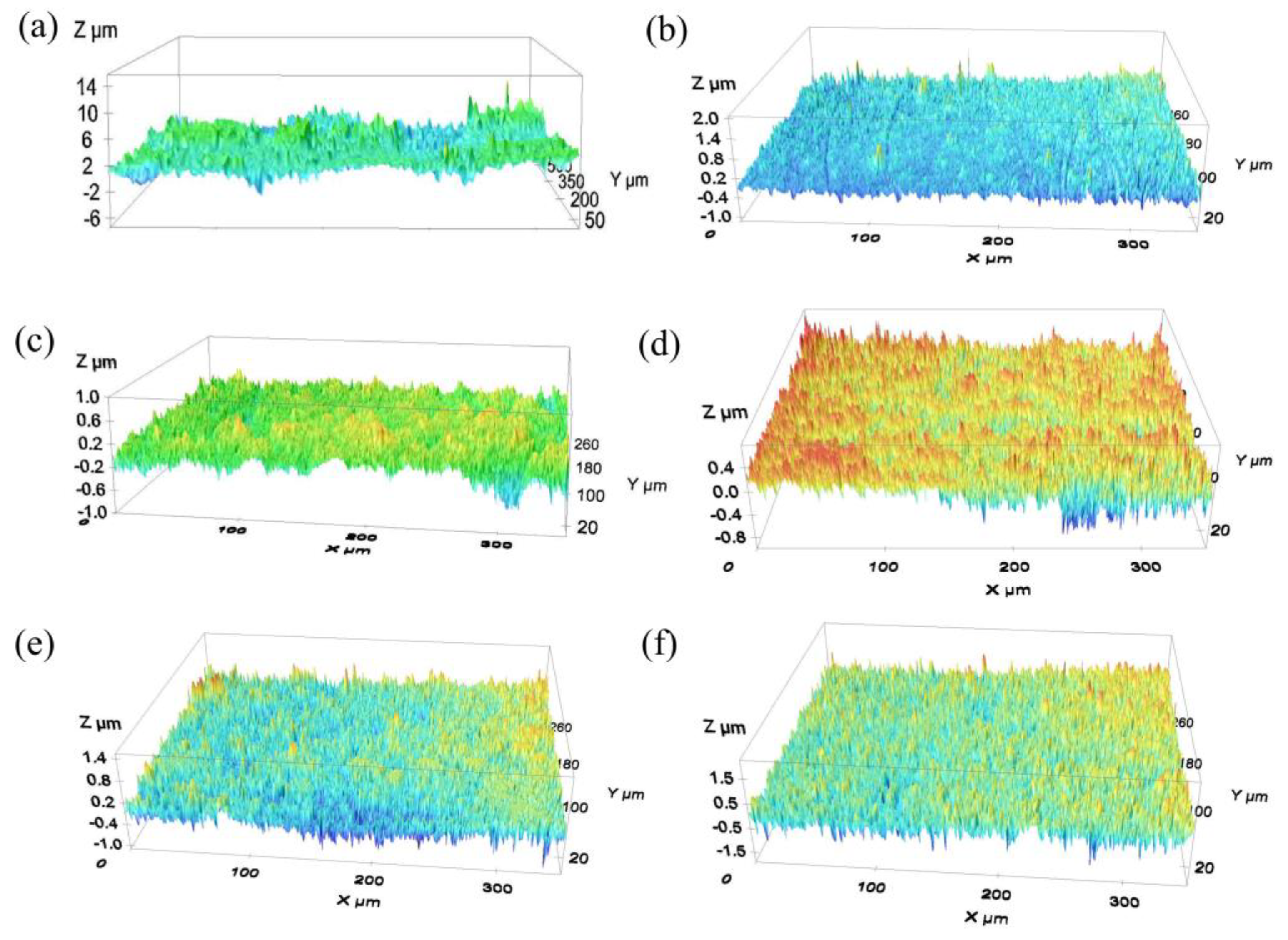
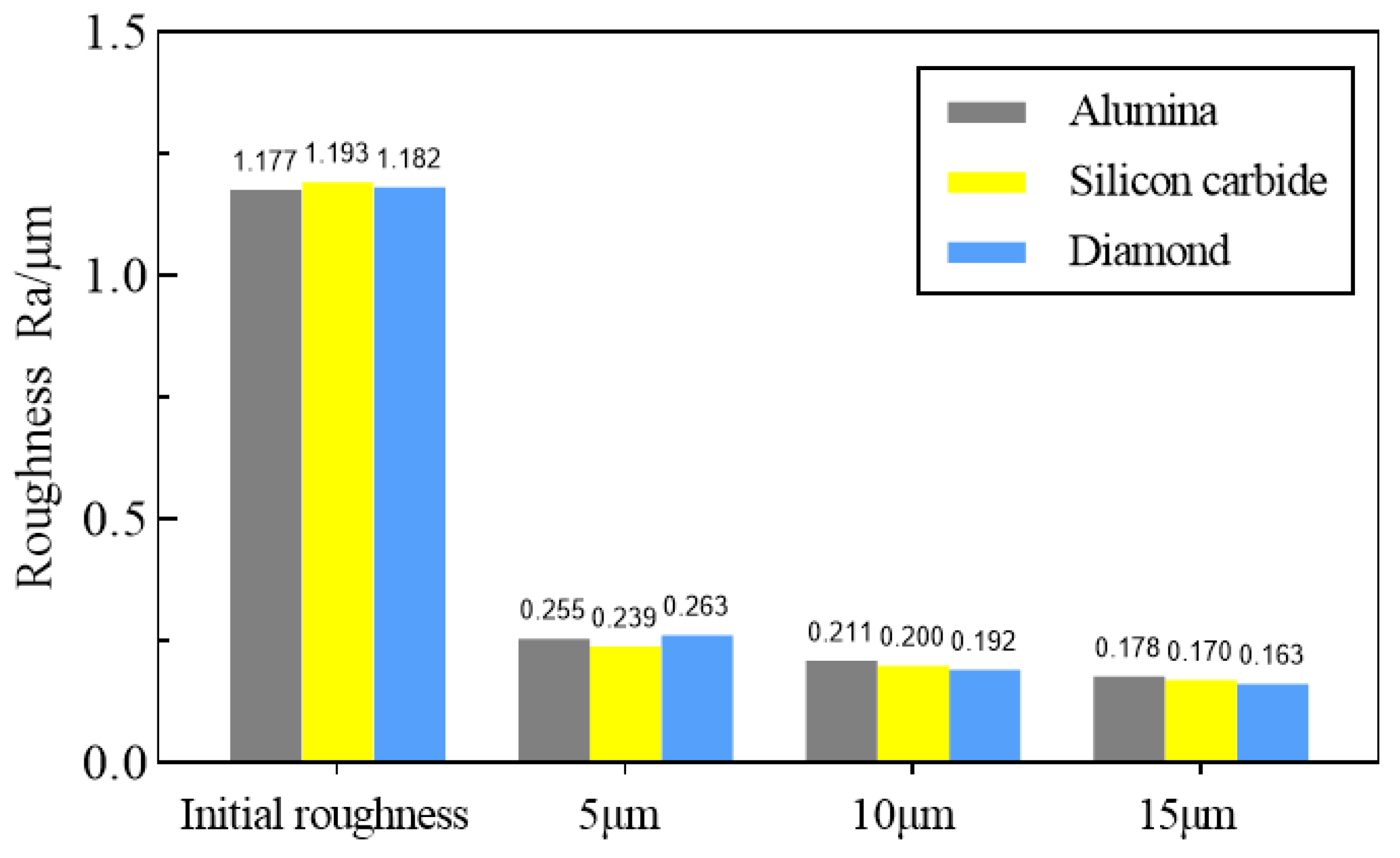
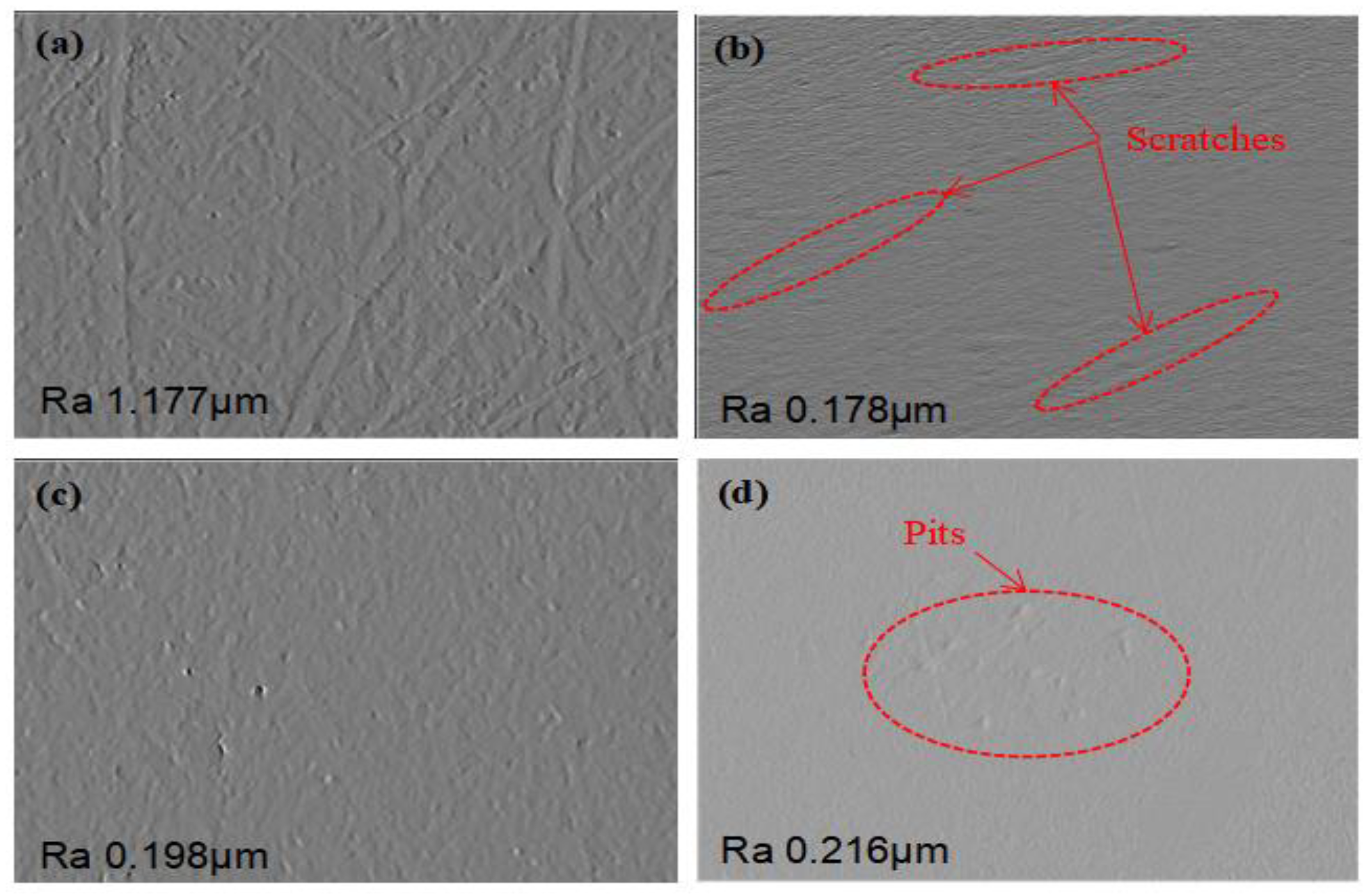
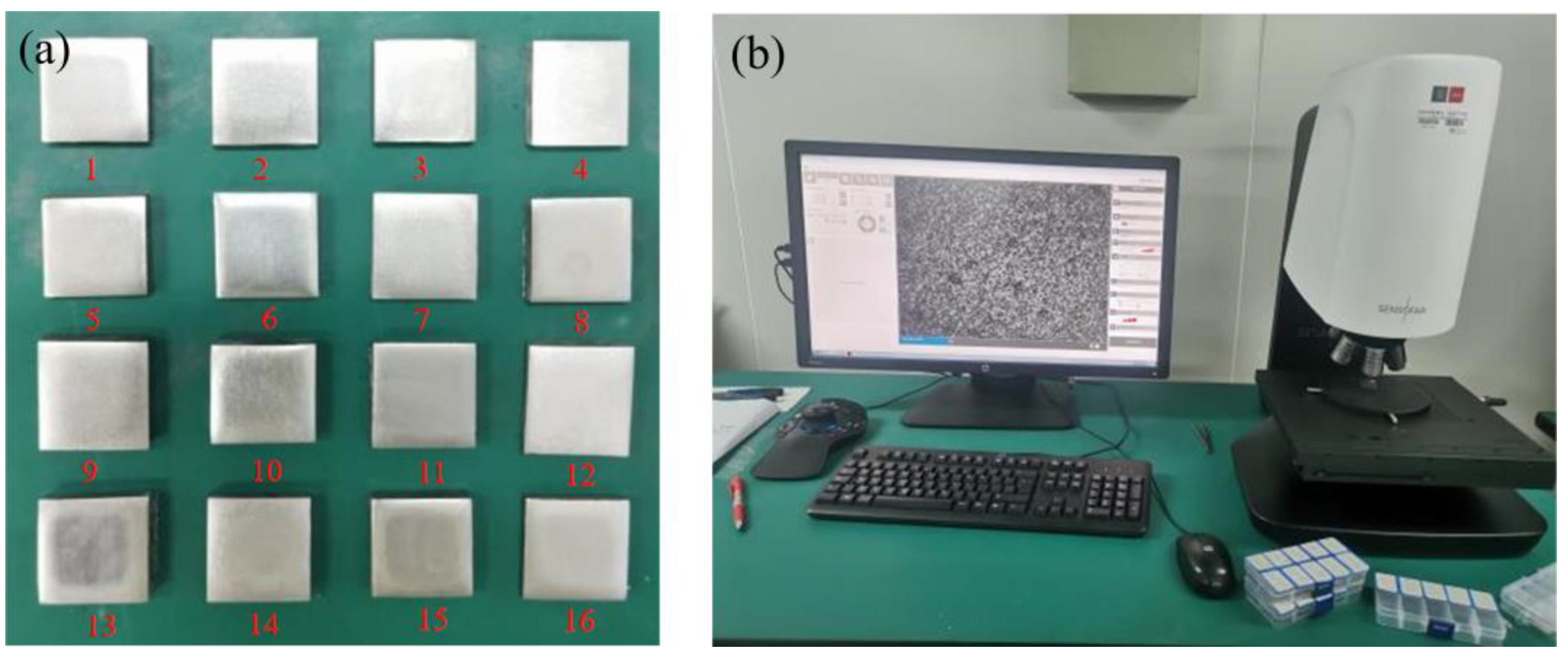
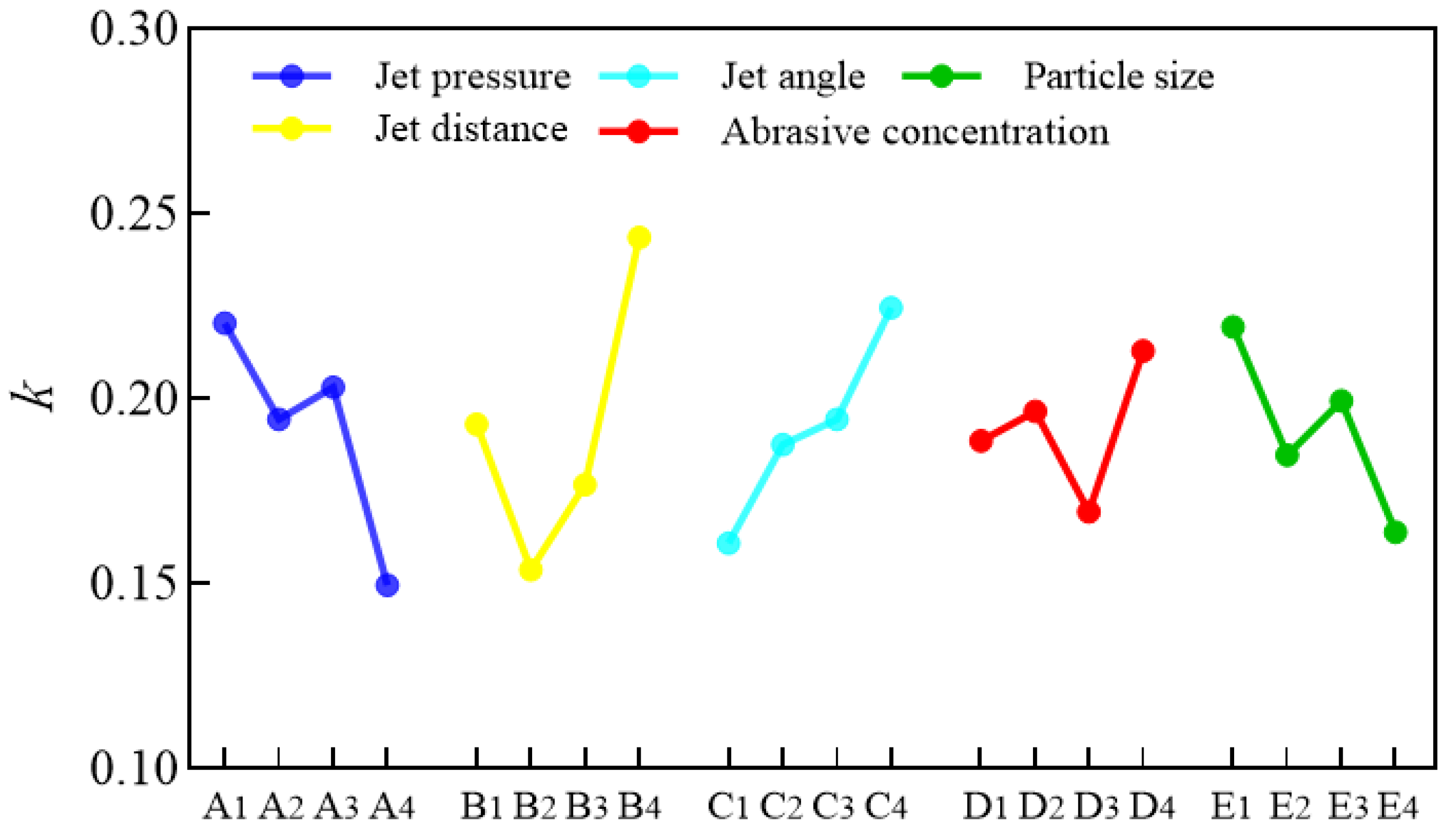
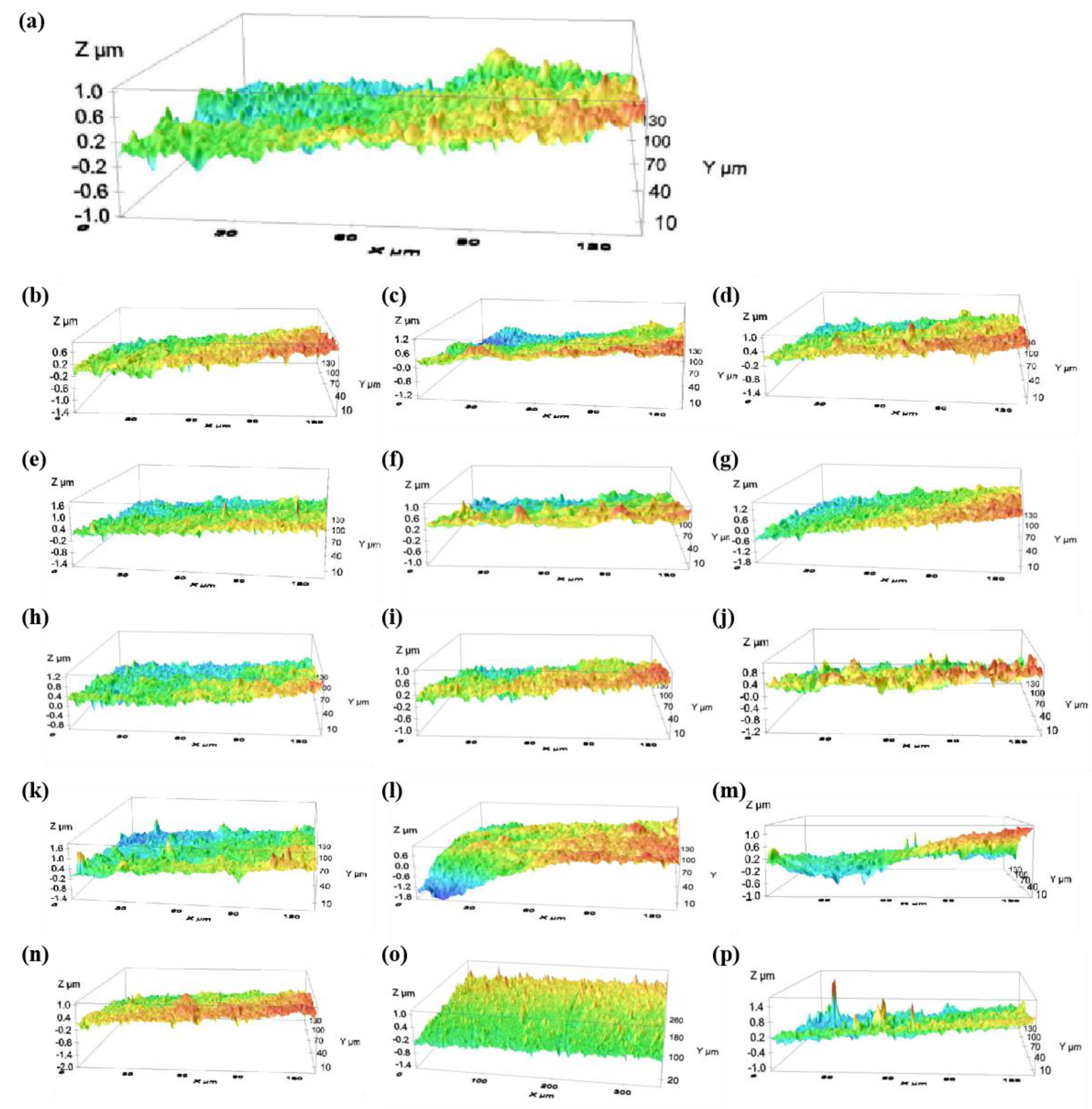
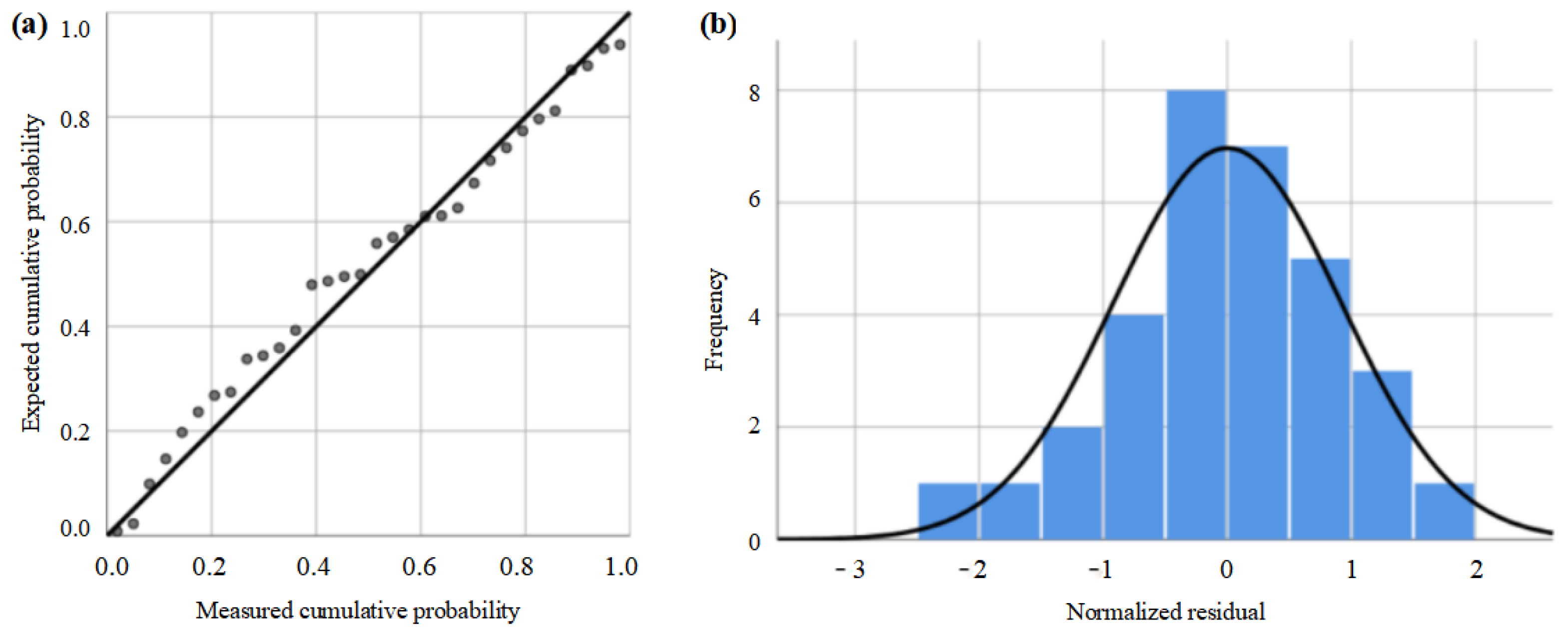
| Factors | A | B | C | D | E | |
|---|---|---|---|---|---|---|
| Levels | Jet Pressure/MPa | Jet Distance/mm | Jet Angle/° | Abrasive Concentration/% | Particle Size/μm | |
| 1 | 0.2 | 4 | 30 | 4 | 4 | |
| 2 | 0.4 | 6 | 45 | 6 | 6 | |
| 3 | 0.6 | 8 | 60 | 8 | 10 | |
| 4 | 0.8 | 10 | 90 | 10 | 15 | |
| Experiment Number | A | B | C | D | E | Roughness (μm) |
|---|---|---|---|---|---|---|
| Jet Pressure/MPa | Jet Distance/mm | Jet Angle/° | Abrasive Concentration/% | Particle Size/μm | ||
| 1 | 0.2 | 4 | 30 | 4 | 4 | 0.215 |
| 2 | 0.2 | 6 | 45 | 6 | 6 | 0.155 |
| 3 | 0.2 | 8 | 60 | 8 | 10 | 0.193 |
| 4 | 0.2 | 10 | 90 | 10 | 15 | 0.319 |
| 5 | 0.4 | 4 | 45 | 8 | 15 | 0.162 |
| 6 | 0.4 | 6 | 30 | 10 | 10 | 0.154 |
| 7 | 0.4 | 8 | 90 | 4 | 6 | 0.181 |
| 8 | 0.4 | 10 | 60 | 6 | 4 | 0.281 |
| 9 | 0.6 | 4 | 60 | 10 | 6 | 0.200 |
| 10 | 0.6 | 6 | 90 | 8 | 4 | 0.203 |
| 11 | 0.6 | 8 | 30 | 6 | 15 | 0.155 |
| 12 | 0.6 | 10 | 45 | 4 | 10 | 0.255 |
| 13 | 0.8 | 4 | 90 | 6 | 10 | 0.196 |
| 14 | 0.8 | 6 | 60 | 4 | 15 | 0.104 |
| 15 | 0.8 | 8 | 45 | 10 | 4 | 0.179 |
| 16 | 0.8 | 10 | 30 | 8 | 6 | 0.120 |
| K1 | 0.882 | 0.773 | 0.644 | 0.755 | 0.878 | |
| K2 | 0.778 | 0.616 | 0.751 | 0.787 | 0.656 | |
| K3 | 0.813 | 0.708 | 0.778 | 0.678 | 0.798 | |
| K4 | 0.599 | 0.975 | 0.899 | 0.852 | 0.740 | |
| k1 | 0.2205 | 0.19325 | 0.161 | 0.18875 | 0.2195 | |
| k2 | 0.1945 | 0.154 | 0.18775 | 0.19675 | 0.185 | |
| k3 | 0.20325 | 0.177 | 0.1945 | 0.1695 | 0.1995 | |
| k4 | 0.14975 | 0.24375 | 0.22475 | 0.213 | 0.164 | |
| R | 0.07075 | 0.08975 | 0.06375 | 0.0435 | 0.0555 | |
| Optimal levels | A4 | B2 | C1 | D3 | E4 |
| Items | Sum of Squares | Degrees of Freedom | Mean Square | F | Significant | Partial Eta Square |
|---|---|---|---|---|---|---|
| Correction model | 0.76 a | 15 | 0.005 | 3.943 | 0.002 | 0.747 |
| Intercept | 0.695 | 1 | 0.695 | 539.077 | 0.000 | 0.964 |
| Jet pressure (A) | 0.019 | 3 | 0.006 | 4.913 | 0.010 | 0.324 |
| Jet distance (B) | 0.017 | 3 | 0.006 | 4.394 | 0.016 | 0.392 |
| Jet angle (C) | 0.025 | 3 | 0.008 | 6.450 | 0.003 | 0.297 |
| Abrasive concentration (D) | 0.008 | 3 | 0.003 | 2.166 | 0.124 | 0.096 |
| Particle size (E) | 0.009 | 3 | 0.003 | 2.210 | 0.118 | 0.104 |
| Error | 0.026 | 20 | 0.001 | |||
| Total | 1.564 | 36 |
| Model | Non Normalized Coefficient | Normalized Coefficient | t | Significant | Sum of Square | |
|---|---|---|---|---|---|---|
| Beta | Error | Beta | ||||
| Constant | −3.208 | 0.051 | 3.392 | 0.002 | ||
| Jet pressure | −0.217 | 0.041 | −0.446 | −3.325 | 0.002 | |
| Jet distance | 0.171 | 0.004 | 0.227 | 1.691 | 0.101 | |
| Jet angle | 0.279 | 0.000 | 0.470 | 3.500 | 0.001 | |
| Abrasive concentration | 0.073 | 0.004 | −0.055 | −0.412 | 0.683 | |
| Particle size | −0.109 | 0.002 | −0.100 | −0.745 | 0.462 | |
| Regression | 0.000 a | 0.047 | ||||
| Residual | 0.055 | |||||
| Total | 0.102 | |||||
| R square | 0.747 | |||||
| No. | Jet Pressure (MPa) | Jet Distance (mm) | Jet Angle (°) | Abrasive Concentration (%) | Particle Size (μm) | Xp (μm) | Xr (μm) |
|---|---|---|---|---|---|---|---|
| 1 | 0.5 | 5 | 50 | 5 | 10 | 0.159 | 0.143 |
| 2 | 0.2 | 2 | 35 | 2 | 10 | 0.141 | 0.148 |
| 3 | 0.3 | 3 | 40 | 3 | 10 | 0.178 | 0.182 |
| 4 | 1.0 | 10 | 90 | 10 | 10 | 0.204 | 0.216 |
| 5 | 0.1 | 1 | 20 | 1 | 10 | 0.236 | 0.204 |
| 6 | 0.6 | 6 | 55 | 6 | 10 | 0.165 | 0.179 |
| 7 | 0.8 | 8 | 70 | 8 | 10 | 0.178 | 0.163 |
| 8 | 0.7 | 7 | 60 | 7 | 10 | 0.169 | 0.183 |
| 9 | 0.9 | 9 | 80 | 9 | 10 | 0.185 | 0.187 |
| 10 | 0.4 | 4 | 45 | 4 | 10 | 0.154 | 0.142 |
| No. | Xp (μm) | Xr (μm) | Absolute Error | Relative Error (%) | Average Relative Error (%) |
|---|---|---|---|---|---|
| 1 | 0.159 | 0.143 | 0.008 | 5.3 | 6.2 |
| 2 | 0.141 | 0.148 | 0.007 | 4.7 | |
| 3 | 0.178 | 0.182 | 0.004 | 2.2 | |
| 4 | 0.204 | 0.216 | 0.012 | 5.6 | |
| 5 | 0.236 | 0.204 | 0.022 | 10.3 | |
| 6 | 0.165 | 0.179 | 0.014 | 7.8 | |
| 7 | 0.178 | 0.163 | 0.015 | 9.2 | |
| 8 | 0.169 | 0.183 | 0.014 | 7.7 | |
| 9 | 0.185 | 0.187 | 0.002 | 1.1 | |
| 10 | 0.154 | 0.142 | 0.012 | 8.5 |
Disclaimer/Publisher’s Note: The statements, opinions and data contained in all publications are solely those of the individual author(s) and contributor(s) and not of MDPI and/or the editor(s). MDPI and/or the editor(s) disclaim responsibility for any injury to people or property resulting from any ideas, methods, instructions or products referred to in the content. |
© 2023 by the authors. Licensee MDPI, Basel, Switzerland. This article is an open access article distributed under the terms and conditions of the Creative Commons Attribution (CC BY) license (https://creativecommons.org/licenses/by/4.0/).
Share and Cite
Zhang, L.; Ding, C.; Bu, J.; Zhang, Z.; Wang, Y.; Fan, C. Process Optimization of Polishing Titanium Alloy Material with a Pulsating Air Jet. Materials 2023, 16, 6813. https://doi.org/10.3390/ma16206813
Zhang L, Ding C, Bu J, Zhang Z, Wang Y, Fan C. Process Optimization of Polishing Titanium Alloy Material with a Pulsating Air Jet. Materials. 2023; 16(20):6813. https://doi.org/10.3390/ma16206813
Chicago/Turabian StyleZhang, Lei, Chen Ding, Jianfa Bu, Zhirui Zhang, Yongguang Wang, and Cheng Fan. 2023. "Process Optimization of Polishing Titanium Alloy Material with a Pulsating Air Jet" Materials 16, no. 20: 6813. https://doi.org/10.3390/ma16206813
APA StyleZhang, L., Ding, C., Bu, J., Zhang, Z., Wang, Y., & Fan, C. (2023). Process Optimization of Polishing Titanium Alloy Material with a Pulsating Air Jet. Materials, 16(20), 6813. https://doi.org/10.3390/ma16206813







